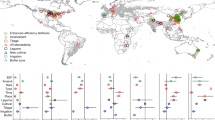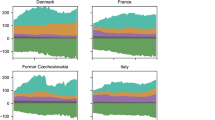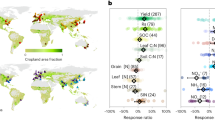Abstract
Maintaining food production while reducing agricultural nitrogen pollution is a grand challenge under global climate change. Yet, the response of global agricultural nitrogen uses and losses to climate change on the temporal and spatial scales has not been fully characterized. Here, using historical data for 1961–2018 from over 150 countries, we show that global warming leads to small temporal but substantial spatial impacts on cropland nitrogen use and losses. Yield and nitrogen use efficiency increase in 29% and 56% of countries, respectively, whereas they reduce in the remaining countries compared with the situation without global warming in 2018. Precipitation and farm size changes would further intensify the spatial variations of nitrogen use and losses globally, but managing farm size could increase the global cropland nitrogen use efficiency to over 70% by 2100. Our results reveal the importance of reducing global inequalities of agricultural nitrogen use and losses to sustain global agriculture production and reduce agricultural pollution.
This is a preview of subscription content, access via your institution
Access options
Access Nature and 54 other Nature Portfolio journals
Get Nature+, our best-value online-access subscription
$29.99 / 30 days
cancel any time
Subscribe to this journal
Receive 12 digital issues and online access to articles
$119.00 per year
only $9.92 per issue
Buy this article
- Purchase on Springer Link
- Instant access to full article PDF
Prices may be subject to local taxes which are calculated during checkout





Similar content being viewed by others
Data availability
Data supporting the findings of this study are available within the article and its Supplementary Information files. All data are publicly available and open access. Source data are provided with this paper.
Code availability
All analyses were performed using Stata version 16.0. Codes that allow the estimates to be reproduced are available in the Supplementary Information.
References
IPCC Climate Change 2014: Synthesis Report (eds Core Writing Team, Pachauri, R. K. & Meyer, L. A.) (IPCC, 2014).
Kirchmeier-Young, M. C. & Zhang, X. Human influence has intensified extreme precipitation in North America. Proc. Natl Acad. Sci. USA 117, 13308–13313 (2020).
Alizadeh, M. R. et al. A century of observations reveals increasing likelihood of continental-scale compound dry–hot extremes. Sci. Adv. 6, eaaz4571 (2020).
Xu, C., Kohler, T. A., Lenton, T. M., Svenning, J. & Scheffer, M. Future of the human climate niche. Proc. Natl Acad. Sci. USA 117, 11350–11355 (2020).
Zhao, C. et al. Temperature increase reduces global yields of major crops in four independent estimates. Proc. Natl Acad. Sci. USA 114, 9326–9331 (2017).
Erisman, J. W., Sutton, M. A., Galloway, J., Klimont, Z. & Winiwarter, W. How a century of ammonia synthesis changed the world. Nat. Geosci. 1, 636–639 (2008).
Steffen, W. et al. Planetary boundaries: guiding human development on a changing planet. Science 347, 1259855 (2015).
Zhang, X. et al. Managing nitrogen for sustainable development. Nature 528, 51–59 (2015).
Oenema, O. et al. Nitrogen Use Efficiency (NUE): An Indicator for the Utilization of Nitrogen in Agriculture and Food Systems (EU Nitrogen Expert Panel, 2015).
Reay, D. S. et al. Global agriculture and nitrous oxide emissions. Nat. Clim. Change 2, 410–416 (2012).
Sutton, M. A. et al. Towards a climate-dependent paradigm of ammonia emission and deposition. Phil. Trans. R. Soc. B 368, 20130166 (2013).
Huang, X. et al. A high-resolution ammonia emission inventory in China. Glob. Biogeochem. Cycles 26, B1030 (2012).
Sun, Y. et al. The warming climate aggravates atmospheric nitrogen pollution in Australia. Research 2021, 9804583 (2021).
Bowles, T. M. et al. Addressing agricultural nitrogen losses in a changing climate. Nat. Sustain. 1, 399–408 (2018).
Sinha, E., Michalak, A. M. & Balaji, V. Eutrophication will increase during the 21st century as a result of precipitation changes. Science 357, 405–408 (2017).
Wuepper, D., Le Clech, S., Zilberman, D., Mueller, N. & Finger, R. Countries influence the trade-off between crop yields and nitrogen pollution. Nat. Food 1, 713–719 (2020).
Ren, C. et al. The impact of farm size on agricultural sustainability. J. Clean. Prod. 220, 357–367 (2019).
Ren, C. et al. Fertilizer overuse in Chinese smallholders due to lack of fixed inputs. J. Environ. Manage. 293, 112913 (2021).
Shew, A. M., Tack, J. B., Nalley, L. L. & Chaminuka, P. Yield reduction under climate warming varies among wheat cultivars in South Africa. Nat. Commun. 11, 4408 (2020).
Zaveri, E. & Lobell, B. D. The role of irrigation in changing wheat yields and heat sensitivity in India. Nat. Commun. 10, 4144 (2019).
Pfleiderer, P., Schleussner, C. F., Kornhuber, K. & Coumou, D. Summer weather becomes more persistent in a 2 °C world. Nat. Clim. Change 9, 666–671 (2019).
Zaveri, E., Russ, J. & Damania, R.Rainfall anomalies are a significant driver of cropland expansion. Proc. Natl Acad. Sci. USA 117, 10225–10233 (2020).
Wang, X. et al. Global irrigation contribution to wheat and maize yield. Nat. Commun. 12, 1235 (2021).
Higginbottom, T. P., Adhikari, R., Dimova, R., Redicker, S. & Foster, T. Performance of large-scale irrigation projects in sub-Saharan Africa. Nat. Sustain. 4, 501–508 (2021).
Castellano, M. J., Archontoulis, S. V., Helmers, M. J., Poffenbarger, H. J. & Six, J. Sustainable intensification of agricultural drainage. Nat. Sustain. 2, 914–921 (2019).
Wang, J., Klein, K. K., Bjornlund, H., Zhang, L. & Zhang, W. Adoption of improved irrigation scheduling methods in Alberta: an empirical analysis. Can. Water Resour. J. 40, 47–61 (2015).
Mogollón, J. M. et al. Assessing future reactive nitrogen inputs into global croplands based on the Shared Socioeconomic Pathways. Environ. Res. Lett. 13, 044008 (2017).
Marcacci, G. et al. Large-scale versus small-scale agriculture: disentangling the relative effects of the farming system and semi-natural habitats on birds’ habitat preferences in the Ethiopian highlands. Agric. Ecosyst. Environ. 289, 106737 (2020).
Li, Y. et al. Farmland size increase significantly accelerates road surface rill erosion and nutrient losses in southern subtropics of China. Soil Tillage Res. 204, 104689 (2020).
Li, Y. et al. Increase in farm size significantly accelerated stream channel erosion and associated nutrient losses from an intensive agricultural watershed. Agric. Ecosyst. Environ. 295, 106900 (2020).
Levins, R. A. & Cochrane, W. W. The treadmill revisited. Land Econ. 72, 550–553 (1996).
Ritchie, M. & Ristau, K. Crisis by Design: A Brief Review of U.S. Farm Policy (League of Rural Voters Education Project, 1987).
Pretty, J. et al. Global assessment of agricultural system redesign for sustainable intensification. Nat. Sustain. 1, 441–446 (2018).
Gu, B. et al. A credit system to solve agricultural nitrogen pollution. Innovation 2, 100079 (2021).
Wang, S. et al. Urbanization can benefit agricultural production with large-scale farming in China. Nat. Food 2, 183–191 (2021).
Gu, B., Zhang, X., Bai, X., Fu, B. & Chen, D. Four steps to food security for swelling cities. Nature 566, 31–33 (2019).
O Neill, B. C. et al. The effect of education on determinants of climate change risks. Nat. Sustain. 3, 520–528 (2020).
Roe, S. et al. Contribution of the land sector to a 1.5 °C world. Nat. Clim. Change 9, 817–828 (2019).
Mayer, A., Hausfather, Z., Jones, A. D. & Silver, W. L. The potential of agricultural land management to contribute to lower global surface temperatures. Sci. Adv. 4, eaaq0932 (2018).
Wei, Y. et al. Self-preservation strategy for approaching global warming targets in the post-Paris Agreement era. Nat. Commun. 11, 1624 (2020).
Hoegh-Guldberg, O. et al. The human imperative of stabilizing global climate change at 1.5 °C. Science 365, eeaw6974 (2019).
Lowder, S. K., Skoet, J. & Singh, S. What Do We Really Know About the Number and Distribution of Farms and Family Farms Worldwide? Background Paper for the State of Food and Agriculture 2014. ESA Working Paper No. 14–02 (FAO, 2014).
Ackerman, D., Millet, D. B. & Chen, X. Global estimates of inorganic nitrogen deposition across four decades. Glob. Biogeochem. Cycles 33, 100–107 (2019).
Ortiz-Bobea, A., Ault, T. R., Carrillo, C. M., Chambers, R. G. & Lobell, D. B. Anthropogenic climate change has slowed global agricultural productivity growth. Nat. Clim. Change 11, 306–312 (2021).
Gu, B., Ju, X., Chang, J., Ge, Y. & Vitousek, P. M. Integrated reactive nitrogen budgets and future trends in China. Proc. Natl Acad. Sci. USA 112, 8792–8797 (2015).
Zhang, X. et al. Ammonia emissions may be substantially underestimated in China. Environ. Sci. Technol. 51, 12089–12096 (2017).
Savin, R., Sadras, V. O. & Slafer, G. A. Benchmarking nitrogen utilisation efficiency in wheat for Mediterranean and non-Mediterranean European regions. Field Crop. Res. 241, 107573 (2019).
Rosenzweig, C. et al. Assessing agricultural risks of climate change in the 21st century in a global gridded crop model intercomparison. Proc. Natl Acad. Sci. USA 111, 3268–3273 (2014).
Schlenker, W. & Lobell, D. B. Robust negative impacts of climate change on African agriculture. Environ. Res. Lett. 5, 014010 (2010).
Agnolucci, P. et al. Impacts of rising temperatures and farm management practices on global yields of 18 crops. Nat. Food 1, 562–571 (2020).
Wang, X. et al. Emergent constraint on crop yield response to warmer temperature from field experiments. Nat. Sustain. 3, 908–916 (2020).
Tack, J., Lingenfelser, J. & Jagadish, S. V. K. Disaggregating sorghum yield reductions under warming scenarios exposes narrow genetic diversity in US breeding programs. Proc. Natl Acad. Sci. USA 114, 9296–9301 (2017).
Acknowledgements
This study was supported by the National Key Research and Development Project of China (2022YFD1700700, 2022YFE0138200), National Natural Science Foundation of China (42261144001 and 42061124001), and Pioneer and Leading Goose R&D Program of Zhejiang (2022C02008).
Author information
Authors and Affiliations
Contributions
B.G. designed the study. C.R. conducted the research. B.G. and C.R. wrote the first draft of the paper. X.Z. and S.R. revised the paper. X.Z., J.J. and S.W. processed the raw data. All authors contributed to the discussion and revision of the paper.
Corresponding author
Ethics declarations
Competing interests
The authors declare no competing interests.
Peer review
Peer review information
Nature Food thanks Luis Lassaletta, Huizhong Shen and the other, anonymous, reviewer(s) for their contribution to the peer review of this work.
Additional information
Publisher’s note Springer Nature remains neutral with regard to jurisdictional claims in published maps and institutional affiliations.
Extended data
Extended Data Fig. 1 Physical impacts of temperature, precipitation and farm size changes on yield, fertilization, NUE and N surplus in 2018.
(a), (d), (g), and (j) present the impacts of temperature change on yield, fertilization, NUE, and N surplus, respectively. The impacts of temperature and precipitation changes are shown in panels (b), (e), (h), and (k). Combined impacts of temperature, precipitation and farm size are depicted in panels (c), (f), (i), and (l). The impact on each country refers to the physical change compared to the actual observed value in 2018. The geographic coordinates of maps can be found in Fig. 1a. The base map is applied without endorsement from GADM data (https://gadm.org/).
Extended Data Fig. 2 Fertilization changes with yield under temperature, precipitation and farm size changes in 2018.
FV, Fruits and Vegetables; Other, Other Crops. Circles in each panel are country-level data in 2018. Circles with different colors represent seven types of countries with different dominated crop categories including wheat, rice, maize, pulses, vegetables and fruits, other crops, and mixed cropping, respectively. Panel (a) and (b) present the relative and physical changes related to temperature rising, respectively. The relative and physical impacts of temperature and precipitation changes are shown in panels (c) and (d), respectively. Combined impacts of temperature, precipitation and farm size are depicted in panels (e) and (f).
Extended Data Fig. 3 Farm size change from 1961 to 2018.
Panel (a) depicts the global average change in farm size from 1961 to 2018. Panel (b) shows the spatial relative change (%) in 2018 compared to that in 1961. The geographic coordinates of maps can be found in Fig. 1a. The base map is applied without endorsement from GADM data (https://gadm.org/).
Extended Data Fig. 4 Yield, fertilization, NUE and N surplus trends under SSP-RCP scenarios.
Panel (a), (d), (g) and (j) shows yield, fertilization, NUE and N surplus trends only considering temperature, respectively. And panel (b), (e), (h) and (k) represent yield, fertilization, NUE and N surplus trends under both temperature and precipitation changes. The right panels ((c), (f), (i), (l)) represent trends further considering the role of farm size. All global means in this figure are weighted and taken as three-year moving averages.
Extended Data Fig. 5 Spatial patterns of yield, fertilization, NUE and N surplus in 2018.
(a) Yield; (b) Fertilization; (c) NUE; (d) N surplus. The geographic coordinates of maps can be found in Fig. 1a. The base map is applied without endorsement from GADM data (https://gadm.org/).
Extended Data Fig. 6 Yield, fertilization, NUE and N surplus changes in 2100 under SSP5-RCP8.5 scenario.
Value changes refer to the relative change (%) in this figure. It is calculated by the value difference simulated between 2015 and 2100 under the SSP5-RCP8.5 scenario divided by the actual observed value in 2015 and the result is carried out in percentage terms. The left panels ((a), (d), (g), (j)) show changes under the SSP5-RCP8.5 scenario only considering the temperature. Panels in the middle ((b), (e), (h), (k)) present the combined effects of temperature and precipitation. The right panels ((c), (f), (i), (l)) represent changes further considering the role of farm size. The geographic coordinates of maps can be found in Fig. 1a. The base map is applied without endorsement from GADM data (https://gadm.org/).
Extended Data Fig. 7 Global temperature, precipitation and farm size changes under SSP-RCP scenarios.
SSP126, SSP1-RCP2.6; SSP245, SSP1-RCP4.5; SSP585, SSP5-RCP8.5. (a) Temperature changes of croplands compared to 2015; (b) Precipitation changes of croplands compared to 2015; (c) Farm size from 2020 to 2100.
Extended Data Fig. 8 Relative effects of temperature, precipitation and farm size changes on NUE, fertilization and yield across different regions.
Panel (a)-(g) shows the relative effects in seven types of countries with crop categories of wheat, rice, maize, pulses, vegetables and fruits, other crops, and mixed cropping, respectively. In each panel, the three bars on the left refer to the effects in the small farm size group (less than 1 ha). Accordingly, the three on the right represent the effects in the large farm size group (more than 1 ha). The effects were derived from the ratio of the standardization coefficient of the explanatory variable to the standard deviation of the explained variable according to equation (5). The effects from temperature and precipitation have summed the effects from itself and its quadratic items in each farm size group. Note that for countries with crop category of rice, the average farm size on the country level is all less than 1 ha.
Supplementary information
Supplementary Information
Supplementary Methods, Tables 1–12, Figs. 1–7 and Code availability.
Source data
Source Data Fig. 1
Statistical source data.
Source Data Fig. 2
Statistical source data.
Source Data Fig. 3
Statistical source data.
Source Data Fig. 4
Statistical source data.
Source Data Fig. 5
Statistical source data.
Source Data Extended Data Fig. 1
Statistical source data.
Source Data Extended Data Fig. 2
Statistical source data.
Source Data Extended Data Fig. 3
Statistical source data.
Source Data Extended Data Fig. 4
Statistical source data.
Source Data Extended Data Fig. 5
Statistical source data.
Source Data Extended Data Fig. 6
Statistical source data.
Source Data Extended Data Fig. 7
Statistical source data.
Source Data Extended Data Fig. 8
Statistical source data.
Rights and permissions
Springer Nature or its licensor (e.g. a society or other partner) holds exclusive rights to this article under a publishing agreement with the author(s) or other rightsholder(s); author self-archiving of the accepted manuscript version of this article is solely governed by the terms of such publishing agreement and applicable law.
About this article
Cite this article
Ren, C., Zhang, X., Reis, S. et al. Climate change unequally affects nitrogen use and losses in global croplands. Nat Food 4, 294–304 (2023). https://doi.org/10.1038/s43016-023-00730-z
Received:
Accepted:
Published:
Issue Date:
DOI: https://doi.org/10.1038/s43016-023-00730-z
This article is cited by
-
Managing fragmented croplands for environmental and economic benefits in China
Nature Food (2024)
-
High resolution spatiotemporal modeling of long term anthropogenic nutrient discharge in China
Scientific Data (2024)
-
Challenges of optimal crop management
Nature Food (2024)
-
Maize Straw and Nitrogen Fertilizer Alter Soil Carbon and Nitrogen Mineralization during the Fallow Period in the Oasis Farmland area
Journal of Soil Science and Plant Nutrition (2024)
-
Nitrogen use efficiency of tomorrow
Nature Food (2023)



